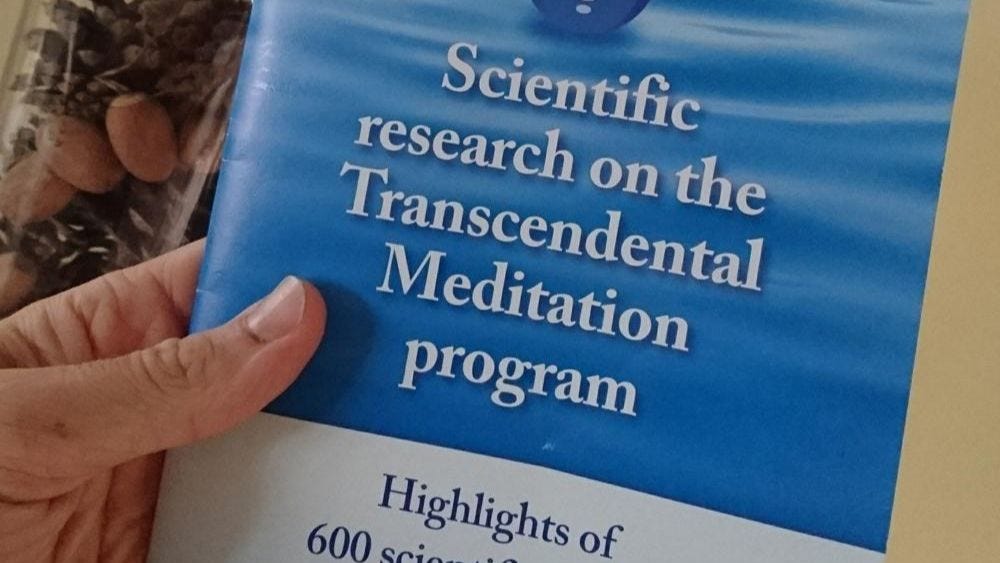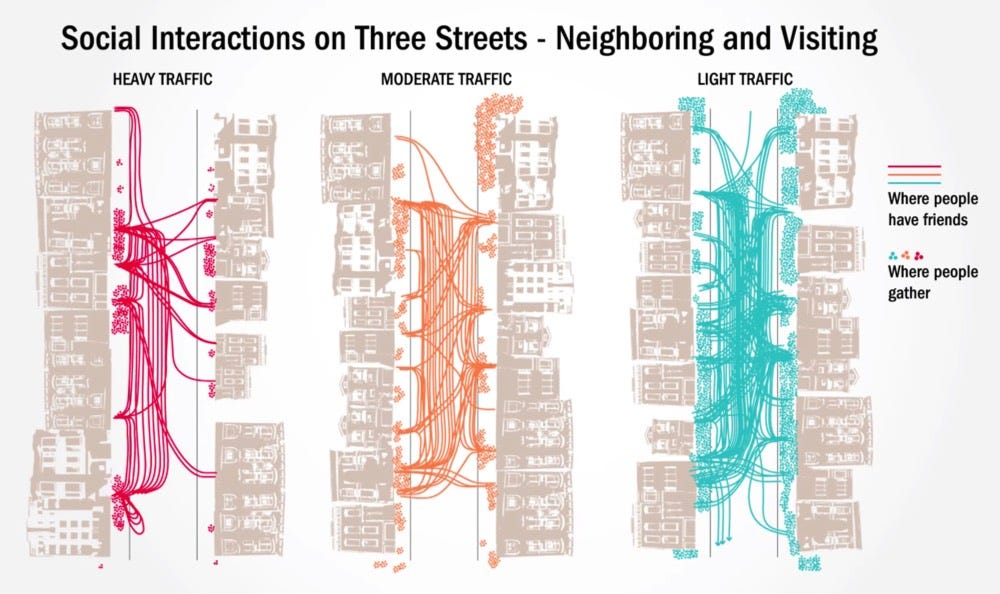Meditations on Transcendental Meditations

Happy Friday!
This week I believe in Meditation!
Over the course of four days just before Christmas I learnt the Transcendental Meditation® technique.
Transcendental Meditation® is a simple form of meditation that involves sitting with eyes closed while mentally repeating a meaningless mantra for 20 minutes, twice a day.
I was given my mantra in a ceremony that involved incense, a photograph of a dead guru, a single white handkerchief, a Russet, a pineapple and a credit card.
As someone open to experiments with consciousness, I took up regular meditation in March 2018, practising for anything from 2 to 25 minutes a day, every day.
But meditation never quite found a regular habit-making slot in my day. I never even really knew what kind of meditation I would settle on until I’d sat down.
Vipassana? Body scan? Loving-kindness? Mindfulness?
It didn’t really seem to matter because most of the time I was fretting about work anyway. And then fretting about why I couldn’t meditate properly.
Although I didn’t miss a day between March and December, sometimes it was a close-run thing, and often I’d end up cramming in 5 minutes before bed.
All in all, I was left with the faintly unsatisfactory feeling that meditation had more to offer.
So when generous benefactors offered to pay for me to take a Transcendental Meditation® course, I was delighted.
This post is about what I learnt, starting with all the things about Transcendental Meditation® that make me want to throw up. Starting with…
Those bloody ®s!
Transcendental Meditation® and its promulgators the Maharishi Foundation® seem irritatingly obsessed with protecting their intellectual property.
It’s not only the constant assertion of ®, but we were also made to sign an agreement that promised we wouldn’t tell anyone else about our personal experiences.
They say that this is to reduce expectations of other people coming to the practice, but their whole sales technique is about raising completely unrealistic expectations.
Browse through the Transcendental Meditation® website or brochures and you’ll find promises (scientifically proven!) that the unique Transcendental Meditation® practice will reduce crime, cure Irritable Bowel Syndrome and insomnia, and basically write that film script for you!
This is, essentially, nonsense. So I feel no shame whatsoever in breaking my agreement and telling as many people as will listen about my experience – exactly as I have done for other similar practices like Vipassana and Psychedelic Breathwork.
The science is overstated and crappy
On a more serious note, the scientific evidence for the benefits of Transcendental Meditation® is massively overstated by the Maharishi Foundation®.
This makes things very confusing for people without the inclination to go trawling through the hundreds of publications to see whether there is any merit at all in what the website claims.
Luckily, we don’t have to go trawling because there is a whole chapter on the science of Transcendental Meditation® in Miguel Farias and Catherine Wikholm’s excellent book The Buddha Pill.
So far as Farias and Wikholm can tell (and they are both academic psychologists), most of the research was done without good controls, without any placebo, and by researchers with prior interest in the outcome of their experiments, who have cherry-picked favourable results without reporting those that are more inconvenient.
This unhappy conclusion casts doubt on everything the Maharishi Foundation® claims. Is it even worth practising Transcendental Meditation® at all?
Amazingly, however, there has been one placebo-controlled, double-blind trial that tested the claims of Transcendental Meditation®.
Results support the conclusion that the crucial therapeutic component of TM is not the TM exercise.
Psychotherapeutic effects of transcendental meditation with controls for expectation of relief and daily sitting. Smith, Jonathan C. Journal of Consulting and Clinical Psychology (1976)
In other words, Transcendental Meditation® works as well as sitting quietly in a chair for 20 minutes twice a day.
As far as I’m concerned, this is great news – it works! (At reducing anxiety in college students, at least.)
But you will be less than astonished to learn that this paper is not cited anywhere among the hundreds listed on the Transcendental Meditation® website.
Oh, and it’s appallingly authoritarian, exclusively expensive, and essentially amoral
The Maharishi Foundation® seems to promote a very authoritarian, paternalistic view of the world.
On the wall of the room in which I studied was an enormous schematic of the Transcendental Meditation® world view. It runs from the Unified Field of Pure Consciousness right up to the Head of State – who is, of course, a male.
Every head of state can fulfil his parental role of bringing maximum success and happiness to his people, and thereby create unified field based ideal civilization through the application of Maharishi’s Unifield Field Based Integrated Systems of Education, Health, Government, Rehabilitation, Economics, Defense, and Agriculture.
(c) International Association for the Advancement of the Science of Creative Intelligence (1983)
Scary.
Especially as, thanks to its £290 to £590 price tag, Transcendental Meditation® is also very exclusive. Hmm. Not sure I want to be a part of yet another boys club.
Side Bar: PSI
If you want a practice that gives you all the benefits of Transcendental Meditation® without the exorbitant price tag, then try periodic somatic inactivity – the meditation placebo created by Jonathan Smith for the paper cited above.
Twice a day, sit comfortably on a chair, or upright in bed.
Close your eyes for 20 minutes.
Let your mind do whatever it wants. Whatever you do mentally will have little or no impact on the effectiveness of the technique. The important thing is to remain physically inactive. Do not talk, walk around, or change chairs. You may engage in an occasional action such as shifting your position or making yourself more comfortable. And you may scratch.
At the end of the session, open your eyes, breathe deeply a few times, and continue with your everyday activities.
Adapted from The Buddha Pill by Miguel Farias and Catherine Wikholm.
Finally, there is nothing in the initial Transcendental Meditation® training about ethics. Yeah, ethics! It’s all very well connecting to the unified field of pure consciousness for 20 minutes twice a day, but what about the other 23 hours and 20 minutes?
Transcendental Meditation® is Hindu meditation stripped clean of the supporting ethical framework – presumably so it would be more appealing to our godless Western minds – but in throwing out the bathwater, we have also lost the baby.
Nevertheless…
Despite these complaints, I enjoy doing the practice, by and large. It’s a good excuse to sit and becalm myself.
I enjoy doing it in the morning, I enjoy doing it in the middle of the day, I enjoy doing it on public transport, I enjoy doing it before I go to sleep.
I have never consciously dedicated time to relaxation this regularly ever before in my entire life.
As far as I can tell from my experience (and this is supported by the more rigorous studies) the benefits of Transcendental Meditation® are similar if not identical to any form of relaxation.
However, this should not be underestimated (or misunderestimated).
Any practice that can actually convince human beings to switch off for 20 minutes twice a day is doing a fine job.
It doesn’t really matter to me that the scientific claim that Transcendental Meditation® is unique is total nonsense: it will still make me less stressed, less anxious and lower my blood pressure. Probably.
The method is simple (without being easy) and structured and, as a result, many people are able to stick to the practice for 20 minutes twice a day.
That is a considerable achievement and for that reason alone I would say that Transcendental Meditation® – if you can afford it, if nothing else seems to stick, if you can look past the bad science, and if you can fill the ethical vacuum – is worth trying.
Just don’t expect miracles.
Tim Ferriss, podcaster and self-help celebrity, also took the Transcendental Meditation® course, and seems to have had a similar experience.
For me, [TM] is what kicked off more than 2 years of consistent meditation. I’m not a fan of everything the TM organization does, but their training is practical and tactical. … The social pressure of having a teacher for 4 consecutive days was exactly the incentive I needed to meditate consistently enough to establish the habit.
And if you find that Transcendental Meditation® doesn’t work for you, then don’t worry: there are a multitude of ways to find whatever it is that people call transcendence.
Try self-hypnotism, progressive relaxation, roller-blading, walking in nature, breathwork, yoga, a different form of meditation, climbing a mountain or contemplating the ocean, psychedelic trips large and small.
Good luck!
FICTION-NON-FICTION
Snippets from my reading in the last seven days.
FICTION
Gormenghast by Mervyn Peake (1950)
Bellgrove frowned like God considering the state of the world on the Third Day. A knowing smile played across his old mouth but it appeared to have lost its way among the wrinkles.
NON-FICTION
Meditations by Marcus Aurelius (~180AD)
Does the sun try to do the rain's work? (6.43)
Phew! That took about 3 hours to write - so thank you and congratulations for making it to the end.
This weekend I'm learning how to give first aid outdoors, as a precursor to taking my Lowland Leader Award in February. So perhaps next week I'll write something shorter about that.
Until then, much love,
- dc

CREDITS
David Charles wrote this newsletter. David is co-writer of BBC Radio sitcom Foiled, and also writes for The Bike Project, Elevate and Thighs of Steel. He can be found at davidcharles.info and on Twitter @dcisbusy

In 1981, a Berkeley urban design professor named Donald Appleyard published a book called Livable Streets (now out of print). In it, he described the results of research he’d done in the late 1960s about the effects of car traffic on the people who live in cities.
For the study, he selected three similar residential streets in San Francisco that only differed in the amount of street traffic and then measured how the residents used their streets.
Kottke.org


